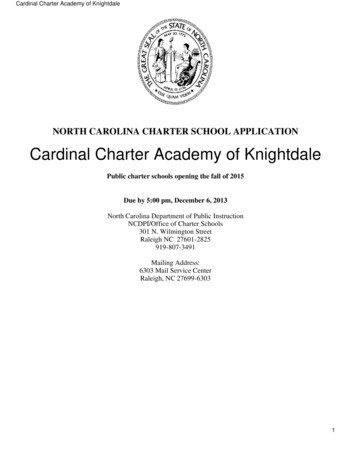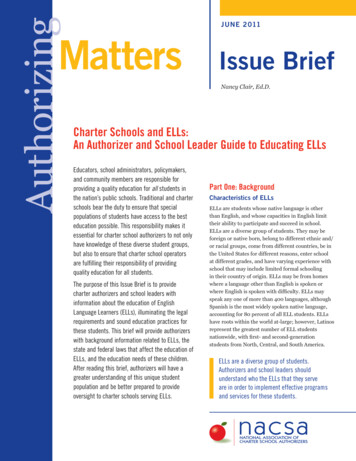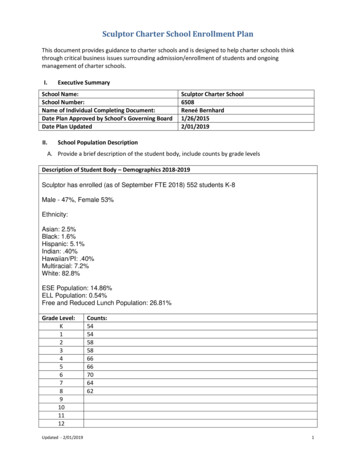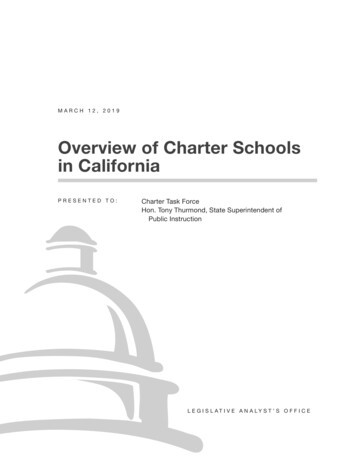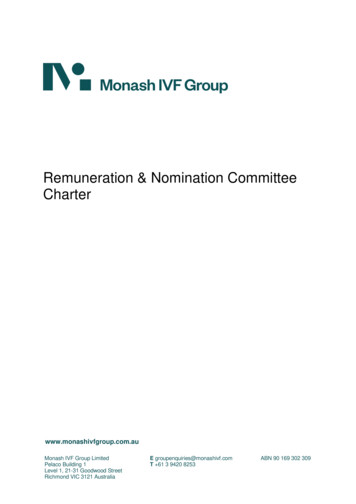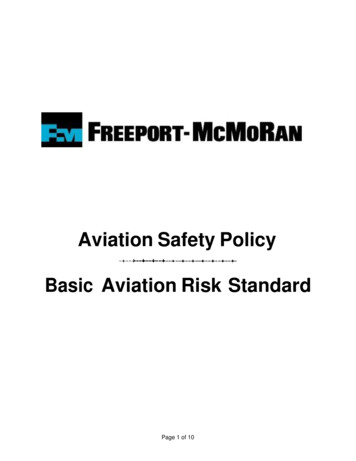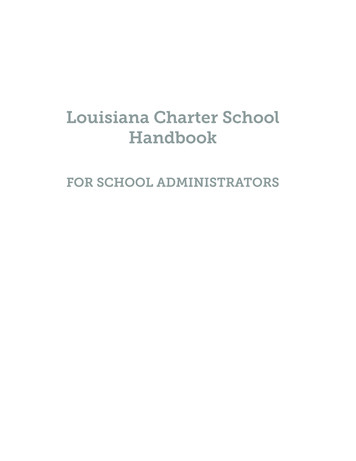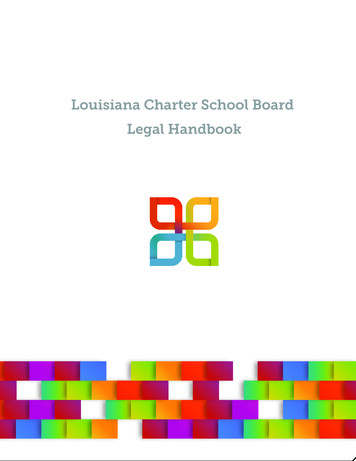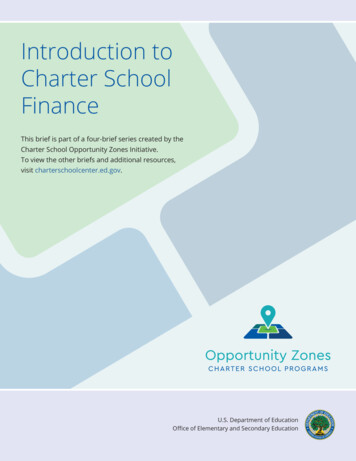
Transcription
FLORIDA CHARTER SCHOOLS:NOT AS GOOD, OR AS BAD, AS ADVERTISEDFEBRUARY 2020
Tough Choices Facing Florida’s GovernmentsFLORIDA CHARTER SCHOOLS:Not as Good, or as Bad, as AdvertisedTABLE OF CONTENTSINTRODUCTION.2SCHOOL CHOICE AND FLORIDA CHARTER SCHOOLS. 3RACIAL AND ECONOMIC DIVERSITY IN CHARTER SCHOOLS. 7RACIAL COMPOSITION IN CHARTER AND TRADITIONAL SCHOOLS.7ECONOMIC SEGREGATION.10IMPACT ON NEARBY TRADITIONAL SCHOOLS. 11FLORIDA’S RELIANCE ON FOR-PROFIT CHARTERS.14PERFORMANCE DIFFERENCES .16ACCOUNTABILITY AND OVERSIGHT IN CHARTER SCHOOLS. 21MEASURING INNOVATION. 22TRANSPARENCY AND PARENTAL CHOICE. 23CONCLUSION. 25RECOMMENDATIONS.26APPENDIX TABLES.28REFERENCES.46ENDNOTES. 50FLORIDA CHARTER SCHOOLS: Not as Good, or as Bad, as Advertised1
Tough Choices Facing Florida’s GovernmentsFLORIDA CHARTER SCHOOLS:Not as Good, or as Bad, as AdvertisedFlorida, as a state, has a very active school choice environment which includes traditional public schools, publiccharter schools, open enrollment policies and even scholarships for students who meet certain criteria. All of thisis aimed to provide parents with high-quality options that best meet the needs of their child. However, in 2017, theCollins Institute report entitled “Patterns of Resegregation in Florida’s Schools” revealed some startling trends withinour public school systems across the state. There was some concern that public charter schools were exacerbatingthe resegregation trend. Subsequently, the Collins Insititute board in 2017, as a public policy research institute,decided to take a closer look at racial diversity, accountability, innovation and transparency in Florida’s public charterschools to better understand some key questions about charter schools in Florida, and how they contribute toFlorida’s school choice landscape and student outcomes. Key findings from the work include: Florida is home to the most enthusiastic users of charter schools in the country. Some 10 percent of Floridastudents are in charter schools, compared to the national average of six percent. In Miami-Dade, nearly onein five students in public schools attend charters. It is impossible to overstate the diversity of charter schools, to the point that conclusions such as “charterschools are better/worse than traditional schools” are meaningless. In the initial enabling legislation in 1996, diversity was included as a component of the contractual agreementwith the sponsor.1 However, there are few, if any, ways districts can hold charters to their racial/ethnicrepresentation of the community, and the legislature has largely ignored diversity since the initial enactment. Florida’s charter schools are highly racially and ethnically segregated—as are its traditional schools. Charterschools outside South Florida are most likely to be white. There is evidence that charter schools throughoutthe state are more economically segregated than traditional schools. Recent years have seen a trend toward a steady centralization of the state role and a reduction in localdistrict oversight over charter schools. Innovation was one of the purposes of charter schools in the 1996 law but has proven difficult to measure.Charter schools are not held accountable for innovation and there is no infrastructure to share innovativeideas. Transparency is important in a policy based on parent/student choice. The state and districts collect a greatdeal of information on charters and traditional schools, but it is not provided to parents in a way that theycan easily compare charters to each other and to traditional schools. For-profit management companies, known as Education Management Organizations or EMOs, are activein the state (two large companies are based in Florida). Over 40 percent of Florida charter schools aremanaged by for-profit companies— the second highest state percentage in the country. In Miami-Dade, 77percent of charter schools are Education Management Organizations (EMOs).These findings flow from our examination of the history of charter schools in Florida, analysis of questions relatedto charter schools and segregation, and special attention to accountability, innovation and transparency. The reportconcludes with a set of recommendations. Given that fiscal issues surrounding charter schools are such an importantissue, we plan to deal with them in a separate report.The report draws primarily on Florida data and research conducted on Florida schools. It also reviews researchconducted nationally. When comparing Florida schools and their performance to other states, it is important to bearin mind several differences:2 For the most part, charter school policy in Florida has been applied uniformly across the board to all districts.(Some states restrict charter schools to a few, usually urban, districts; some states have different charterschool policies for different types of districts; and a number of states cap the number of charter schools.) Florida has a higher density of charter schools relative to other states. Moreover, Florida relies more heavilyon for-profit schools relative to other states. With 67 school districts, Florida has fewer (and larger) school districts than most other states. Texas, forexample, has over 1,000 public school districts.FLORIDA CHARTER SCHOOLS: Not as Good, or as Bad, as Advertised
Tough Choices Facing Florida’s GovernmentsSCHOOL CHOICE AND FLORIDACHARTER SCHOOLSThe rationale for school choice is competition. Scholars such as Chubb and Moe (1990) argue that the failures ofpublic education systems can be attributed to a lack of competition in the educational marketplace. With competition,the argument goes, the overall quality of education will improve. Schools which fail to respond to market demandswill go out of business. While Chubb and Moe do not explicitly address charter schools in their analysis, charterschools are a means to introduce competition into the public education system and indeed, policy and some scholarshave argued that traditional schools will improve when charters compete with them. 2 Opponents counter that schoolchoice reforms hinder the progress of low-performing public schools by attracting the “best” students and withholdingmuch needed funds as students depart and enrollment numbers decline (Ozek, Carruthers, & Holden, 2018).Florida embraced school choice early and enthusiastically. The state’s involvement is generally attributed to GovernorJeb Bush, who was an early and strong supporter of charter schools, even helping set up one of the state’s firstcharter schools in 1996. 3 Bush made education reform a key component of his 1998 gubernatorial campaign,arguing for school choice, increased accountability, and funding incentives for schools achieving desired outcomes.A few months after his election, he spearheaded the passage of the A Plan, which addressed all three components.While there is not a clear-cut definition of school choice policy, we are adopting Miller’s (2015) definition that schoolchoice policies lead to education outside of traditional schools. This includes charter schools, home schooling,virtual education and tax credit programs that fund students transferring to private schools. Magnet schools, interdistrict and intra-district choice policies keep students within public schools and are not included.4Home schooling has been an option in Florida law since 1985. More than 84,000 students are in home educationprograms throughout Florida (FDOE 2019a). Florida Virtual School was established in 1997 as an internet-basedpublic high school. Today, Florida Virtual School is an accredited, statewide public school and is the largest statevirtual school in the nation, and allows students to enroll full-time or part-time (FDOE 2019b).In recent years, legislative activity in Florida (and nationally) has focused on vouchers. Florida has an array ofvoucher programs: Florida’s tax credit scholarship program offers scholarships to low-income students through one of twoauthorized organizations. It provides income tax, severance tax or insurance premium tax credits tocorporations that contribute money to the organizations that award scholarships. It has become a model forother states and is the largest of its kind in the nation (Solochek 2018). The MacKay scholarship, established in 2000, is for students with disabilities who can use the scholarshipto attend a private school or a different public school. 5 The Gardiner Scholarship was created in 2016 for children with certain disabilities, including autism. The Opportunity Scholarship is targeted for students who attend schools with a D or F grade and providesfunding for transportation to another public school with a higher grade (Solochek 2018). The initial programoffered the opportunity to transfer to a participating private school, but the Florida Supreme Court ruled thatthe private school option was unconstitutional. The Hope Scholarship allows students who have been subjected to bullying, harassment, or fighting atschool the opportunity to transfer to another public schools or an approved private school.6In 2019, the legislature expanded the tax credit scholarship by enacting the Family Empowerment ScholarshipProgram, which will be funded directly by the state (instead of indirectly through tax credits) and will be available tofamilies with incomes up to 300 percent of the federal poverty level or 77,250 for a family of four (Saunders 2019).According to the Florida Department of Education (FDOE), some 18,000 students will be provided “life-changingeducation opportunities for academic and career success through this program” (FDOE 2019c). The scholarship canbe used for tuition and fees at participating private schools.FLORIDA CHARTER SCHOOLS: Not as Good, or as Bad, as Advertised3
Tough Choices Facing Florida’s GovernmentsIt is within this schools of choice context that the Collins Institute addressed charter schools. Clearly charter schoolsare only part of this movement—albeit it an important part. For example, Buckley and Schneider (2007) call charterschools, a “mainstay of education reform in the U.S.”Florida’s first charter school law was passed in 1997. HB 539 defined how charters were to be proposed, outlinedthe approval process by the school district boards and the appeal process, terms of the charter, provision of anannual school report and called for funding to be laid out the same as students enrolled in other public schools.Two components were interesting: first, the law provided that sponsors shall not impose unreasonable rules orregulations that violate the intent of giving charter schools greater flexibility to meet educational goals; second, thatcharters address and approval of charters shall be based on (among other things) the ways in which the school willachieve a racial/ethnic balance reflective of the community it serves or within the racial/ethnic range of other publicschools in the same district.Thus, racial diversity was an important component of the first law. Since that time, however, diversity has beenlargely ignored. Only one other law, introduced in 2002, dealt with racial equity. It made every K-20 class availableto all students without regard to race, ethnicity, national origin, gender, disability or marital status. As Miller (2015)concludes, since the original law, there have been no policies intended to increase the diversity of charter schoolpopulations or to monitor charter and public school populations for unintended racial or class segregation as aconsequence of increased school choice.We will examine the racial/ethnic and economic diversity of Florida charter schools and traditional schools. But first,we will address the prevalence and growth of Florida charter schools. Florida, like other states, is moving towardchoice in education, especially in their support of charter schools.Overall, Florida is viewed as a charter-friendly state— the state has about double the percentage of students incharter schools than the national average. Another way to compare Florida statutes on charter schools to otherstates is by using the National Alliance for Public Charter Schools (NAPCS) assessment of state laws (Ziebarth2019). Essentially, the assessment rates every state on the extent to which they have implemented a model statelaw with 21 elements. The NAPCS, an advocacy group for charter schools, is hardly unbiased but their assessmentmight be viewed as the extent to which the state law is friendly to charter schools. Florida is ranked seventh nationally.The group notes that Florida has made strides in recent years to provide more equitable funding to charter schools,does not have a cap on public charter school growth, promotes a fair amount of autonomy and accountability, andprovides a robust appellate process for charter school applicants. Potential areas for improvement (in the January2019 report) include continuing to strengthen equitable funding, creating authorizer accountability requirements, andstrengthening accountability for full-time virtual charter schools. Perhaps notable is that none of the 21 elementsdeal with racial/ethnic diversity.Table 1 shows the growth in number of charter schools in Florida since 2000. (Appendix Table 1 provides everyyear between 2000 and 2018). In 2000 there were 148 charter schools— by 2018 there were 658 charter schoolsin the state. The growth in the number of charter schools continued unabated until 2015 when it appears to haveplateaued. It is important to note that this number reflects the number of schools in operation in a given year, addingnew schools but subtracting those that close.Table 1: Growth in Student Population by School 533,2713,5902,846,857Source: (1) National Center for Education Statistics - http://nces.ed.gov/ccd/elsi/(2) Florida Department of Education – http://fldoe.org4StudentsFLORIDA CHARTER SCHOOLS: Not as Good, or as Bad, as Advertised
Tough Choices Facing Florida’s GovernmentsFigure 1 illustrates the enthusiasm Florida has had for charter schools compared to the rest of the country in termsof the percentage of students enrolled in charter and traditional schools since 2000. The rate of growth of percent ofstudents in charter schools is much steeper in Florida than the nation as a whole. Thus, while the number of schoolshas remained fairly stable in recent years, the number of students attending those schools has continued to grow.In 2016 approximately 10 percent percent of students enrolled in Florida charter schools, while the national averagewas only six percent. 7Charter schools are generally located in urban areas and Florida is no exception. Some 43 percent of all charters inFlorida are in Dade, Broward and Palm Beach counties. (See Figures 1-3 in the appendix for the number of charterschools, number of students in charter schools and percentage of students in charter schools by county.) In MiamiDade, 35 percent of all public schools are charters; in Broward the market share is 30 percent. However, it is alsoimportant to remember that not all districts in Florida have charter schools and the growth in number of countieshas not mirrored the growth in students and schools. In 2000, there were charter schools in 36 districts. By 2008 itexpanded to 43 districts and by 2016, there were charter schools in 47 districts (see Appendix Table 3).Over the last 20 years, approximately 900 charter schools have opened in Florida. Of these, approximately one-thirdhave closed. (See Table 2 for the number of charter school closures each year between 1998 and 2018.)FLORIDA CHARTER SCHOOLS: Not as Good, or as Bad, as Advertised5
Tough Choices Facing Florida’s GovernmentsTable 2. Florida charter school closures between 1998 and 2018YearNumber of 429201526201632201727201821SOURCE: Florida Department of Education, spxIs this level of “churn” disruptive? Districts have expressed frustration about not being able to plan for rising or loweringschool enrollments. Parents complain when a charter school closes and last- minute arrangements have to be securedfor their children. Charters may close because they fail to attract enough students or if there are financial or otherproblems. To date, there is no research on the effects of closures on either students, neighborhood traditional schoolsor on the district.The diversity across the charter school sector is considerable. For example, some charter schools, like the School ofArts and Sciences in Tallahassee, feature a family-model in which students are placed in multi-age classes. There arecharter schools serving the needs of specific populations, such as the Florida Autism School of Excellence in Tampaor schools focusing on drop-out prevention, bilingual students or students with developmental delays. Other charterschools have focused on curricula, highlighting for example the arts or STEM fields, such as River City Science Academyin Jacksonville. Some charter schools, like Bok Academy in Lake Wales, incorporate their unique surroundings in theirprogram. Bok Academy is located at a spring-fed lake enabling them to utilize nature in the school’s curriculum. Withthe help of grants and donations the school has purchased a 30-person pontoon boat with a microscope equippedlaboratory that’s used as a floating classroom.However, one can argue that the assumption that the traditional public sector was too hide-bound to accommodateparent preferences or student diversity is less true today than 20 years ago. For one, there is much more pressureon traditional schools to improve their student learning as a result of both federal and state policies of the last twodecades. Two, diversity within the traditional sector has increased dramatically. There has been considerable growth inchoice within the traditional sector including curricula such as advanced placement (AP), alternative programs such asthe international baccalaureate (IB) program, schools focusing on STEM or on the performing arts and virtual or cyberschooling options. Finally, particularly in Florida, there has been an increase in other types of government-fundedchoice programs including district-level open enrollment, cross-district enrollment options, and voucher programs suchas the Tax Credit Scholarship program and the McKay scholarship program for special need students.6FLORIDA CHARTER SCHOOLS: Not as Good, or as Bad, as Advertised
Tough Choices Facing Florida’s GovernmentsRACIAL AND ECONOMIC DIVERSITY INCHARTER SCHOOLSKEY FINDING: Charter schools are NOT less racially diverse, but are lesseconomically diverse than traditional schools.» Racial Segregation in Charter and Traditional SchoolsThe preponderance of education research shows that charter schools have led to increased segregation by race,ethnicity, disability status and English language proficiency (Rotberg and Glazer 2018). The research highlightsboth increased segregation between white and black students (Renzulli amd Evans, 2005; Garcia, 2008;Frankenberg,Siegel-Hawley and Wang, 2010; Bifulco and Ladd 2007; Cobb and Glass 1999; Ladd, Clotfelter andHolbein 2017; Clotfelter et al. 2018) and between white and Hispanic students (Garcia, 2008; Cowen & Winters 2013).What about Florida? Table 3 shows Florida students’ racial/ethnic composition in charter and traditional schools since2000. For both traditional and charter schools, the percentage of white students in schools has fallen substantiallysince 2000; from 55 percent to 39 percent in traditional schools and from 50 percent to 32 percent for charterschools. The percentage of black students in charter schools has also fallen—from 36 percent to 25 percent. Thepercentage of black students in traditional schools has fallen much less—around three percentage points from 30percent to 27 percent.Table 3: Average Racial Composition of Charter and Traditional Public Schools from 2000 – ther#**1%2%2%2%*#3%2%Note: p-values are denoted 0.00 -- * -- 0.05 -- # -- 0.10Difference of means test compares charter to traditional schools in the same yearSee Appendix Table 4 for all yearsSource: National Center for Education Statistics - http://nces.ed.gov/ccd/elsi/It is the Hispanic growth in both traditional and charter schools that is most notable. The percentage of Hispanicstudents in traditional schools grew from 16 percent to 28 percent; the percent of Hispanic students in charterschools increased even more— from 13 percent to 37 percent over the same time period. It is important to note that2000 was very early for charter schools in Florida so this might be misleading. However, the trends noted above alsoplay out in later years when new charter schools were being added at an impressive rate in the state. Appendix Table4 shows racial composition annually by charter and traditional school since 2000.When we examine the racial makeup of charter and traditional schools in the three major South Florida counties, wesee more pronounced trends (See Table 4). The percentage of black students in charter schools in these counties hasfallen since 2000—from 45 percent in 2000 to 28 percent in 2016. In South Florida, there are higher percentages ofHispanics and substantially lower percentages of black students in charter schools than in traditional schools in thosecounties. Tables 5 a) and b) in the Appendix provides these percentages for every year between 2000 and 2016.It is also noteworthy that outside South Florida, the racial makeup of charters mirror that of traditional schools withabout one-fourth of students in both charter and traditional schools being Black and one-fourth being Hispanic. Thebottom line: the three major South Florida counties—which have large percentages of charter school students—arenot typical of the rest of the state in charter schools’ racial/ethnic makeup.FLORIDA CHARTER SCHOOLS: Not as Good, or as Bad, as Advertised7
Tough Choices Facing Florida’s GovernmentsTable 4: Percentage of Students by Race/Ethnicity in Charter & Traditional Public Schools in Miami-Dade, Broward, and PalmBeach raditional15%36%**#54%*45%2%2%2%2%Total Students50,991*720,770130,514*692,716Note: p-values are denoted 0.00 -- * -- 0.05 -- # -- 0.10Difference of means test compares charter to traditional schools in the same yearSee Appendix Table 5a for all years, and 5b for all districts other than these threeSource: National Center for Education Statistics - http://nces.ed.gov/ccd/elsi/While aggregate statistics are helpful, it is important to also look at the extent of segregation within individual schoolsand to compare those percentages to other schools in the district. The measurement of the extent of segregation canbe called “racial imbalance.” There are several ways to measure racial imbalance. We use two: 1) percentage of thestudents in a charter school attending a 90-100 percent nonwhite school by race/ethnicity, and 2) a school’s racialcomposition relative to other schools in the district. Table 5 presents the first measure of racial imbalance.Table 5: Percentage of Schools by School Type that are Racially Segregated (90-100% nonwhite) from 2000-2016Including the Average Racial Composition of those Schools and Total Enrollment% Segregated Schools % Black in these schools % Hispanic in these schools Total 39%49%*55%43%*82,178490,634Note: p-values are denoted 0.00 -- * -- 0.05 -- # -- 0.10Difference of means test compares charter to traditional schools in the same yearSee Appendix Table 7 for all yearsSource: National Center for Education Statistics - http://nces.ed.gov/ccd/elsi/Overall, charter school students are much more likely to be in a highly segregated school (32 percent) than traditionalschool students in the state (21 percent). As Table 5 notes, in 2000, 27 percent of students in Florida charter schoolswere in highly segregated schools (90-100 percent non-white). By 2016, that percent had risen to 32 percent. Incontrast, in 2000, 13 percent of students were in traditional schools that were highly segregated, rising to 21 percentin 2016. This indicates that traditional schools became more segregated over the 17- year time period than charterschools. However, there are substantially more racially segregated charter schools than traditional schools. (Table6 in the Appendix provides these percentages for traditional and charter schools in every district between2000 and 2016.) However, as Table 5 further illustrates, the differences are largely due to Hispanic students. In 2016,students in racially segregated charter schools were, on average, 55 percent Hispanic, compared to 43 percent fortraditional schools. In contrast, highly segregated charter schools were 39 percent black, while this number was 49percent for traditional schools. Clearly charter schools are more segregated than traditional schools for Hispanics(at a much higher rate) but are LESS segregated than traditional schools for Black students. Appendix Table 7 showsthe percentage of charter and traditional schools in segregated schools since 2000.8FLORIDA CHARTER SCHOOLS: Not as Good, or as Bad, as Advertised
Tough Choices Facing Florida’s GovernmentsCourt-ordered desegregation plans define a racially unbalanced school as one in which the percent of black studentsis either 15 percent higher or 15 percentage points lower than the percent black residents in the district in which thein sscounties,becausewe foundlittleschoolis located.WhenBormanal. (2004)call this atmeasureracialracialcomposition,it is importantit comparesthe schoolto otherschoolsin the anddistrict.A similarschoolsstudy usingmeasureNorthFloridaCarolinafound thatdifferencebetweencharterstraditionalin reinacharterschoolthaninatraditionala slight difference in the rest of the state, although Palm Beach is much more likely to have bothschool(Bifulco andLadd2007). Weanddo notfind thesethesebig differencesFlorida.we Hispaniclooked s.Whenwe break indowntheWhendata byornon-white racial balance across counties, we found little difference between charters and traditional schools in theBlack racial composition (Figures 2 A and B) we see that Miami-Dade is much more likely tothree major South Florida counties and a slight difference in the rest of the state, although Palm Beach is much moreschoolswith 15 percentgreater erlikelyhaveto haveboth segregatedwhite ortraditionalcharterschools.inWhenwe breakdown theby Hispanic anicsegregationincharterBlack racial composition (Figures 2 A and B) we see that Miami-Dade is much more likely to haveschoolsschools with 15thanortraditionalschools.percentgreater blacksegregation in traditional schools than charter schools and more likely to have 15 percentor greater Hispanic segregation in charter schools than traditional schools.Figure 2 A): Percent of Schools Segregated Black15% Threshold4035302520151050BrowardMiami-DadeTradi onalPalm BeachOther DistrictsCharterFigure 2 B: Percent of Schools SegregatedHispanic15% Threshold706050403020100BrowardMiami-DadeTradi onalPalm BeachOther DistrictsCharterSource: Civil Rights Data Collection (CRDC) U.S. Department of Education 2016-17 survey data.Source: Civil Rights Data Collection (CRDC) U.S. Department of Education 2016-17survey data.12FLORIDA CHARTER SCHOOLS: Not as Good, or as Bad, as Advertised9
Tough Choices Facing Florida’s GovernmentsWhat should we make of these findings?First, not surprisingly, charter schools in Florida— like those in other states— locate in urban areas in neighborhoodsthat are highly minority (Greenblatt 2018). Charters in Miami-Dad
schools are a means to introduce competition into the public education system and indeed, policy and some scholars have argued that traditional schools will improve when charters compete with them. 2 Opponents counter that school choice reforms hinder the progress of low-performing public schools by attracting the "best" students and .

